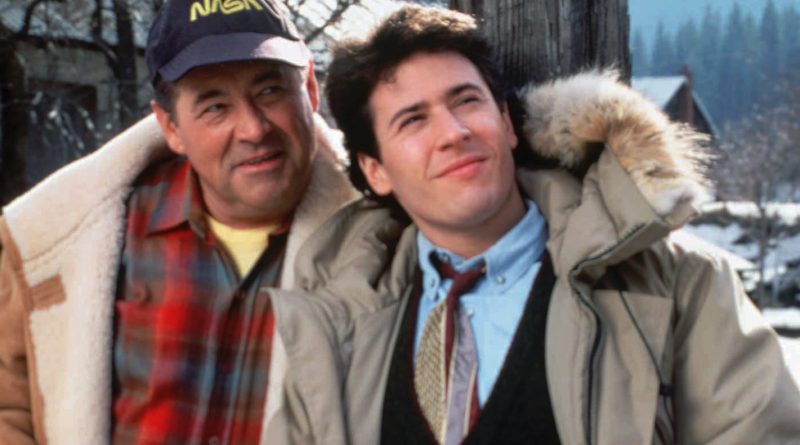Looking back at quirky CBS drama
[ad_1]
Barry Corbin and Rob Morrow in quirky CBS drama “Northern Exposure,” a summer hit in 1990 that lasted six seasons. (Photo: CBS)
Today’s streaming world has made the idea of a summer tryout for a new scripted show go the way of the VCR. But there was a time when it could reap a sizeable reward from the exposure.
“Northern Exposure,” for one.
The acclaimed gefilte-fish-out-of-water show, focusing on a young New York-trained doctor forced to serve the first four years of his practice in backwoods Alaska, made its CBS debut 30 years ago, on July 12, 1990. It turned a low-profile eight-week introduction into a six-season Emmy- and Peabody-winning run.
Featuring an ensemble cast of TV unknowns, and set where few series before it had landed, “Exposure” told of fresh-from-residency Dr. Joel Fleischman (Rob Morrow), contractually bound to set up shop in the 49th state as repayment for its funding of his medical education. He heads west expecting Anchorage. What he gets is the tiny rural hamlet of Cicely (Population: 215), where moose have the Main Street right-of-way.
That the arrogant Fleischman doesn’t take to the place – even as the town populace (or most of it) takes to him – is the stuff of which TV shows are made. And “Exposure” made it like few at the time, with stories often teetering on the edge of reality and its cast lost somewhere between Grover’s Corners and “Green Acres.”
Those who counted Cicely home: an elderly bar owner (John Cullum) and his 40-years-younger new wife (Cynthia Geary); a take-no-prisoners general storekeeper (Peg Phillips); a hunky, ex-con Nietzsche-quoting DJ (John Corbett); a teenaged Spielberg hopeful (Darren E. Burrows); a poker-faced medical-office assistant (Elaine Miles), a Native Alaskan; a beautiful strong-willed bush-pilot (Janine Turner) who serves as Fleischman’s landlord and romantic thorn; and a former-astronaut-turned-self-appointed town boss (Barry Corbin).
Expectations were modest when “Exposure” showed up on CBS’s tundra of a schedule in the summer of 1990. The network was coming off a miserable season that saw just one of 17 new scripted series (family sitcom “Major Dad”) survive. And there was no easy peg on which to hang the show. But its auspices were impressive: creators/producers Joshua Brand and John Falsey had met as writers on the late 1970s hit “The White Shadow” and went on to create the Emmy-winning NBC dramas “St. Elsewhere,” “A Year in the Life” and “I’ll Fly Away.” Early reviews were positive, and “Exposure” found a warm summer reception.
Picked up for another short season in 1990-1991, it didn’t air again until the following spring. But as fans awaited it, word-of-mouth and appreciation grew. In March 1991, a month before the start of its second season, it was honored at the Museum of Television and Radio’s annual TV Festival ( now known as the PaleyFest).
Both season made the show Emmy-eligible, and it secured three 1991 nominations, including Best Drama and Best Writing (for the pilot episode).The show found a regular slot on CBS schedule that fall, for a third season, and by the time that ended, it was prime-time’s hottest show, nominated for 16 Emmys in 1992 and winning six, including Best Drama.
If the early 1990s were about re-inventing comedy with shows like “Seinfeld,” “The Simpsons” and “In Living Color,” “Exposure” did its part to rethink the drama. (The top-rated scripted show at the time was CBS’s “Murder, She Wrote.”) It lived in a literary world observed by critics as magical realism. Episodes ranged from breezy (“Aurora Borealis,” the first-season finale and consistent fan favorite) to bold (the Peabody-winning town-origin story “Cicely”) to prosaic (“A Hunting We Will Go,” which ends with young Ed Chigliak (Burrows) presenting elderly shopkeeper Ruth-Anne (Phillips) a mountaintop grave as a birthday gift).
Shot on location in Washington state, both on a soundstage outside Seattle and in the Cascade Mountains 80 miles south, which doubled for rural Alaska, the series also celebrated the majestic landscape of The Last Frontier as it incorporated both its indigenous people and traditions indigenous.
At the core, however, the twin currents of “Exposure” were Fleischman’s ill-at-ease existence in his new home and his fractious Will-they-or-won’t-they relationship with pilot Maggie O’Connell (Turner). Both came to lose charge as Fleischman settled into Cicely, and once the romance was consummated midway through the fourth season. “Exposure” fervor lessened with viewers, too, likely helped by Morrow’s well-documented discontent tied to his salary demands.
The actor’s own exposure, thanks to a lead role in Robert Redford’s well-regarded “Quiz Show” in 1994 led to his departure from the show. New characters were introduced to compensate. But the series had lost its rooting and CBS’s confidence. and was cancelled in 1995 after 110 episodes.
In its six seasons, “Exposure” shook up the formulaic prime-time world with what might be called TV’s first holistic series, catering to viewers’ emotional and spiritual well-beings. Nominated for 39 Emmys (10 cast members were cited over its run) and praised for its writing, it mined material few other dramas of the time had, from Native American mysticism to lesbian partnerships to Jungian debates. Equal parts philosophical and cartoonish, it was Plato meets Pluto. On the Writer’s Guild of America list of the 101 best written TV series, “Exposure” ranks 53rd.
Read or Share this story: https://www.usatoday.com/story/entertainment/tv/2020/07/10/northern-exposure-turns-30-looking-back-quirky-cbs-drama/3224245001/
